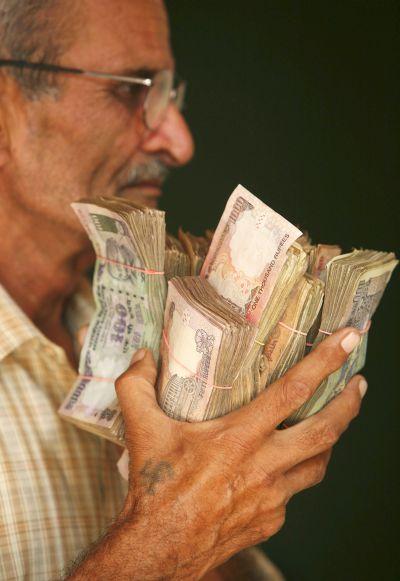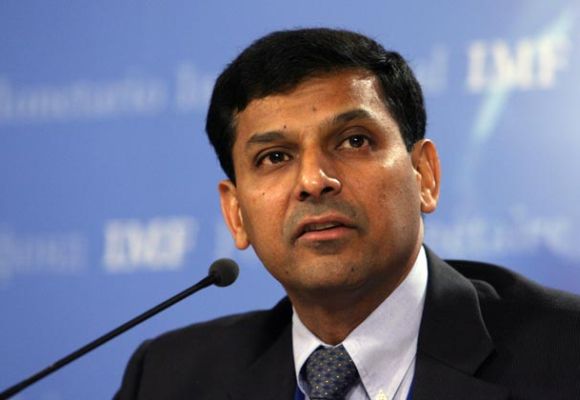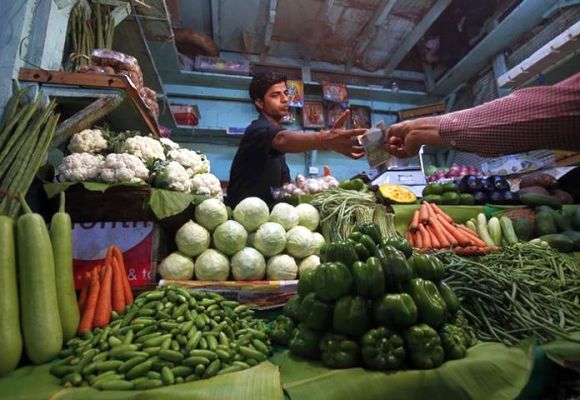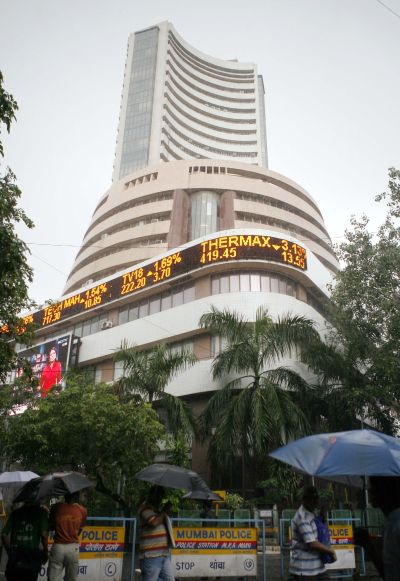Photographs: Mukesh Gupta/Reuters Swati Bhat, Subhadip Sircar and Suvashree Dey Choudhury in Mumbai
If one thing is clear from India's impulsive strategies this month to defend a plunging currency, it is that the Reserve Bank of India's policy bias towards supporting growth is innate, even in a crisis.
When the rupee hit a record low on July 8, the RBI withdrew cash from money markets, making bets against the currency significantly more expensive.
It intervened to stop the currency from dropping beyond 60 per dollar and at the same time tried to assure investors the shock measures were temporary.
To most RBI watchers, this amounted to a menu of stop-gap measures that failed to account for lasting pressure on the currency. To the central bank, it was doing enough to support the rupee without tightening cash conditions so much that it threatened the longer-term growth of an already weak economy.
The eye on growth means it has avoided following its emerging market peers Indonesia, Turkey and Brazil, who all raised their policy rates in anticipation of a long spell of capital outflows as the United States prepares to tighten policy.
…
Why RBI is not doing enough to defend the falling rupee
Image: Reserve Bank of India Governor Duvvuri Subbarao.Photographs: Danish Siddiqui/Reuters
It is unlikely to raise rates either on Tuesday, when it reviews policy, even though analysts argue it should do so if it wants to signal its determination to attract foreign funds and defend the currency.
History suggests these decisions are deliberate and ultimately growth is the overriding factor.
The rupee has fallen 33 per cent against the dollar since 2007. As recently as 2010, the RBI's reluctance to raise interest rates for fear of affecting growth allowed inflation to remain at near double-digit levels for two years.
"The right approach would have been to move the official policy levers," said Rajeev Malik, senior economist at CLSA in Singapore.
Malik feels the central bank might be hoping a temporary tightening of money markets will stabilise the rupee. And that the RBI is either too optimistic or it is wary of announcing a turn in monetary policy.
"Ultimately, at least how I see global liquidity developing, it will be a lose-lose proposition," he said. "India will suffer a GDP downgrade and the rupee will also break 60 in a sustained manner. They have boxed themselves into a corner."
…
Why RBI is not doing enough to defend the falling rupee
Image: India's chief economic adviser Raghuram Rajan.Photographs: Tim Chong/Reuters
To be fair to the central bank, the country's balance of payments problems are beyond its control.
India has historically been a capital-starved economy, with imports and foreign debt servicing bills that far exceed revenues. Capricious governments have done little to ensure a steady stream of foreign investment flows, and India remains one of the most difficult countries in which to do business.
No wonder, critics say, that the current account deficit has blown out to a record 4.8 per cent of gross domestic product, or about $88 billion, in an economy whose growth has slowed to a decade low of 5 per cent and where consumer inflation is nearly 10 per cent.
Collateral Damage
"Yes, exchange rate stability is the focus now in the short-term," said a central bank official, declining to be named as he was not authorised to speak to the media. "But that is because, in the long-term, we want to protect growth for which we have to focus on the exchange rate in the short-term."
That view point was backed up by India's chief economic adviser, Raghuram Rajan, who told a television channel on Thursday that policy measures were geared to stabilising the currency with "minimal damage" to growth.
…
Why RBI is not doing enough to defend the falling rupee
Image: RBI's reluctance to raise interest rates for fear of affecting growth allowed inflation to remain at near double-digit levels for two years.Photographs: Vivek Prakash/Reuters
Tasked with controlling inflation, keeping the economy growing and ensuring financial stability, plus the pressure of pleasing its political masters, it is often of no surprise that the RBI makes growth a priority.
Even though rates were raised 13 times between 2009 and 2011, economists often felt the RBI was behind the curve and allowed prices to stay too high for too long.
Likewise, while the RBI raised rates to defend the rupee during periods of turmoil in 1998, 2000, 2008 and 2011, the policy tightening was often quickly reversed within two to six months, analysts said.
This time, the central bank is in more of a bind than normal. With currency reserves falling rapidly - at $280 billion they cover just 7 months of imports - and external debt worth $172 billion, a fast-slipping currency could eventually risk financial stability.
Yet, raising its 7.25 per cent overnight repo rate would be politically difficult as the ruling coalition has to call a general election by May.
…
Why RBI is not doing enough to defend the falling rupee
Photographs: Punit Paranjpe/Reuters
"Policymakers are trying to achieve a fine balance by squeezing liquidity at the short-end even as they try to cap yields at the long-end," JPMorgan Chase said in a client note. "Yet, some transmission to long rates, funding costs and investment decisions is inevitable."
The RBI's decision to raise its short-term emergency funding rate by 300 basis points has already driven 10-year government bond yields up 100 basis points and short-term corporate debt up 200 basis points across the board.
It is inevitable that growth and therefore foreign inflows into the equity market will be adversely affected, JPMorgan said.
Lose-Lose-Lose?
While the RBI has not explicitly said so, its actions suggest 60-per-dollar is a line in the sand for the exchange rate. Analysts think that is a mistake.
An inability to defend that would hurt market confidence, yet a dogged battle for the level could mean the central bank compromises stability in other parts of the economy, particularly by increasing volatility in money markets.
…
Why RBI is not doing enough to defend the falling rupee
Photographs: Reuters
"Stability in the rupee is what will constitute victory," said Sanjay Mathur, RBS economist based in Singapore. "That may even take a few months and the RBI may be ready for that haul."
Analysts expect stability to mean less volatility in the currency rather than a turnaround and the indications are that the central bank has not won the battle yet. Market expectations of future one-month rupee volatility are still 4 percentage points above the 7 per cent levels of May.
For now, economists expect the central bank to do more of the same: discreet policy tightening through its web of open market operations.
They expect other non-monetary administrative options, such as forcing exporters to bring earnings home quickly or forcing oil importers to stagger their bulky dollar payments, if the pressure is sustained. The government is, meanwhile, examining ways to raise money from non-resident Indians.
"To reverse these measures, the RBI might need to conclude that these steps were ineffective or the costs entailed were too high or the external environment has to improve markedly," said Radhika Rao, economist at DBS in Singapore.
"We don't believe either of these will pan out in the short-term."








article